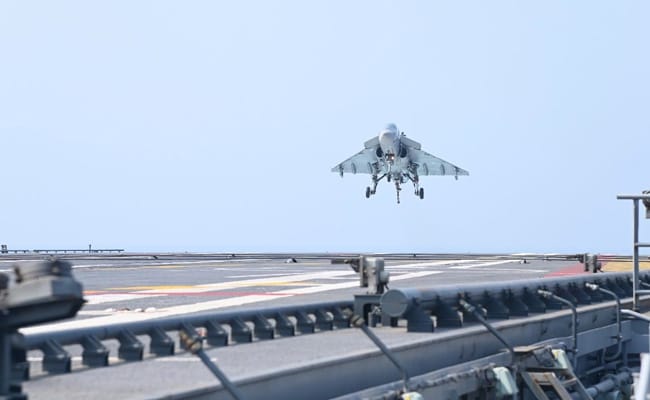2024-02-29 16:57:59

Vikant has a “ski-jump” which provides an elevation to jets like MiG-29K and LCA Tejas to takeoff.
New Delhi:
Aircraft carriers are moving runways that bring fighter jets closer to the battlefield and transport forces to any part of the world. These long warships played a significant role in World War II, especially with bombing operations in the Pacific. Fighter jets have undergone massive technological advancement over the years, but the challenge of landing on an aircraft carrier still exists compared to a conventional airstrip.
How Do Pilots Land?
INS Vikrant and INS Vikramaditya participated in the Milan multination exercise and Vikrant made its grand debut at the nine-day mega exercise. Naval aviators onboard Vikrant explain how they land on a carrier flight deck and the challenges they face.
Watch | #ThrillingThursday | #MILAN2024 | Exclusive
A short runway in the middle of the sea! How does a pilot land his aircraft on a moving ship-pitching, rolling, swaying constantly? Naval pilots onboard #INSVikrant have this to say. pic.twitter.com/duit7iT2tM
— A. Bharat Bhushan Babu (@SpokespersonMoD) February 29, 2024
Vikant has a “ski-jump” which provides an elevation to fighter jets like MiG-29K and LCA Tejas to take off, but when landing, pilots have to calibrate their aircraft speed according to that of the carrier. A conventional runway is 500-600 metres and Vikrant has a 203-metre-long main runway. The landing strip looks like a dot from the fighter jet cruising at high altitudes and the speed and movement of the aircraft carrier on high seas. Naval pilots land on these runways that are moving at a speed of at least 50 km/hr.
‘Extra Precision’
“When we are flying in the sea, there is no reference. We only have a wide ocean, open sky and an aircraft carrier that is always in motion and that one small dot on the deck is our landing spot. The size of the deck is limited and extra precision is required to ensure the fighter jet lands in that limited length,” Lt Commander Ashish, a MiG-29K pilot, said.
The fighter jet descends at a speed of over 200 km/hr, and the tailhook on it has to catch one of the three arresting wires to stop within the limit. For example, LCA Tejas descends at a speed of 240 km/hr and in exactly 90 metres, pilots have to bring the speed down to zero in approximately 2.5 seconds. If the speed is low and the pilot fails to catch the arresting wires and barrier-assisted recovery is not ready, then the aircraft should have enough speed to take off again and turn around for another landing.
Night Landing – Not A No-Brainer
It’s a no-brainer that night landings in pitch darkness are even more challenging and the risk increases manifold. Pilots perform a ‘Night trap’, which means landing on an aircraft carrier during night time.
“Landing on an aircraft carrier is always difficult. From a high altitude, it looks like a matchbox in the sea which is moving, rolling and pitching. At night, the difficulty increases because the indication is from the lights on the carrier deck. These lights indicate the angle of a pilot’s approach, whether it is steep or shallow and they are offered corrections which have to be done in a short period as the aircraft is approaching the deck at very high speeds. A safety officer on the deck constantly monitors the landing and guides the pilot to ensure proper landing,” Lt Commander Parth said.

The pilots also face physical challenges while landing on a flight deck and decelerating from 240 Km/hour to 0 in 2.5 seconds.
Commander Jaideep Maolankar (retd.), an ex-test pilot, said there were instances when the pilots forgot to lock their harnesses, and there was little blood on their feet. The aircraft throws you off, and for 2-3 seconds, you don’t have control over your limbs. Commodore Maolankar was part of the team which tested and engineered the Tejas aircraft when it landed on India’s other aircraft carrier INS Vikramaditya.
INS Vikrant and INS Vikramaditya are built on STOBAR (Short takeoff barrier-assisted recovery) platform. STOBAR carriers have a ski jump. The aircraft carrier, which featured in Top Gun: Maverick was built on the CATOBAR (Catapult take-off barrier assisted recovery) platform. CATOBAR carriers have a flat flight deck and jets are catapulted for takeoff.
Aircraft carrier landing,INS Vikrant,MiG-29K,Indian Navy,LCA Tejas Navy
Source link
![]()



